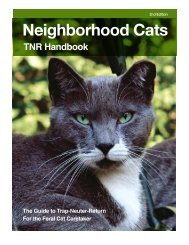Surveying roaming dog populations: guidelines ... - Animal Sheltering
Surveying roaming dog populations: guidelines ... - Animal Sheltering
Surveying roaming dog populations: guidelines ... - Animal Sheltering
Create successful ePaper yourself
Turn your PDF publications into a flip-book with our unique Google optimized e-Paper software.
Introduction<br />
These <strong>guidelines</strong> are the result of a project commissioned by the World Society for the Protection of<br />
<strong>Animal</strong>s (WSPA) to develop survey methods for <strong>roaming</strong> <strong>dog</strong>s that require only a limited investment of<br />
resources. The project was conducted by Conservation Research Ltd using surveys in Cairo, Dar es<br />
Salaam and Colombo with further small-scale trial surveys in Jaipur and Jodhpur, over the period 2005-<br />
7 1 . The primary purpose of the <strong>guidelines</strong> is to support organisations and authorities that are<br />
responsible for the management of <strong>dog</strong> <strong>populations</strong> and require information on those <strong>populations</strong> in<br />
order to plan or evaluate interventions.<br />
In this document, <strong>roaming</strong> <strong>dog</strong>s are defined as <strong>dog</strong>s that are on public areas and not currently under<br />
direct control. This term is often used inter-changeably with ‘free <strong>roaming</strong>’, ‘free ranging’ or ‘stray’ <strong>dog</strong>s.<br />
Note that this term encompasses both owned and unowned <strong>dog</strong>s; it does not distinguish whether or not<br />
the <strong>dog</strong> has an ‘owner’ or ‘guardian’. Indeed, in many countries the majority of <strong>dog</strong>s that would be<br />
defined as <strong>roaming</strong> do have an owner but are allowed to roam on public property for part or all of the<br />
day.<br />
These <strong>guidelines</strong> focus on estimating or monitoring simply the total number of <strong>roaming</strong> <strong>dog</strong>s in public<br />
areas at any one time. For planning and evaluation of an intervention additional information is required,<br />
such as the proportion of <strong>roaming</strong> <strong>dog</strong>s that are owned, however for the following reasons, the number<br />
of <strong>roaming</strong> <strong>dog</strong>s was considered a priority. Firstly, the perception that a <strong>dog</strong> population poses a serious<br />
problem is often related to the population density of <strong>roaming</strong> <strong>dog</strong>s, yet initial estimates of that density<br />
can differ wildly. Secondly it is possible to investigate the number of <strong>roaming</strong> <strong>dog</strong>s prior to any<br />
intervention with a very limited investment of resources. Thirdly an observed change, or lack of change,<br />
in the number of <strong>roaming</strong> <strong>dog</strong>s is likely to be taken as one of the most convincing types of evidence for<br />
the effectiveness, or lack of effectiveness, of the intervention. Yet methods for direct estimation of<br />
<strong>roaming</strong> <strong>dog</strong> numbers appear to have received relatively little attention.<br />
Following a detailed description of a method for estimating the number of <strong>roaming</strong> <strong>dog</strong>s, potential<br />
methods to employ once an intervention has begun are briefly considered.<br />
Most of the methods described in this document are simple to understand and carry out; where we have<br />
described a method or calculation that goes beyond the basics we have indicated this section with the<br />
symbol . However, we encourage readers to explore these sections with the aim of utilising these<br />
methods and calculations, as they will provide a better quality of information. The discussion group is<br />
available for further questions and support.<br />
Why do we need to survey the <strong>dog</strong> population<br />
There are three main reasons for surveying the <strong>roaming</strong> population:<br />
• To assess the need for intervention. This usually involves comparing areas within a city or<br />
comparing different urban areas in order to prioritise where intervention is needed. Areas<br />
with the greatest number or density of <strong>roaming</strong> <strong>dog</strong>s may be chosen as priority areas;<br />
however other factors (e.g. the frequency of complaints about <strong>dog</strong>s, or welfare problems<br />
experienced by <strong>dog</strong>s in certain areas) may also be important for prioritisation.<br />
• To plan an intervention. Counts of the <strong>roaming</strong> population can be combined with<br />
questionnaire surveys to indicate what factors are most significant in maintaining the<br />
<strong>roaming</strong> <strong>dog</strong> population and hence the type and size of intervention needed. This will<br />
dictate the resources required and may suggest targets that should be set to evaluate<br />
progress.<br />
• To evaluate the intervention. Once an intervention is in progress further surveys may be<br />
able to detect changes in the number of <strong>roaming</strong> <strong>dog</strong>s and indicate, in combination with<br />
other factors such as bite incidence and disease prevalence in the <strong>dog</strong> population, the<br />
effectiveness of the intervention.<br />
CONTENTS<br />
INTRODUCTION<br />
COUNTING DOGS<br />
IN PUBLIC AREAS<br />
MONITORING ONCE<br />
CONCLUSIONS<br />
1 Feedback on this document will be very gratefully received through the discussion group at http://groups.google.com/group/<strong>dog</strong>population-survey-<strong>guidelines</strong>.<br />
3<br />
ANNEXES








